Toshka Lakes
This article has an unclear citation style. (August 2009) |
| Toshka Lakes | |
|---|---|
| Coordinates | 23°06′N 30°54′E / 23.1°N 30.9°E |
| Basin countries | Egypt |

Toshka Lakes (Template:Lang-ar, Egyptian Arabic: [boħeˈɾæːt ˈtoʃkæ]) is the name given to recently formed endorheic lakes in the Sahara Desert of Egypt.
The Aswan High Dam, constructed in Egypt in 1964-1968, created Lake Nasser, with a maximum water level of 183 m above sea level. In 1978 Egypt began building the Sadat Canal NW from Lake Nasser through Wadi Toshka to allow water levels higher than 178 m to be drained off into a depression at the south end of the Eocene limestone plateau. In the late 1990s, water began flowing through the Sadat Canal into the Western Desert. This feeder canal from the Nile is concrete lined, to reduce seepage losses. The Nile water does not overflow naturally into the canal, but must be pumped by the vast Mubarak Pumping Station, situated north of Abu Simbel.
Astronauts began noticing the first, easternmost lake growing in November 1998. By late 1999, three additional lakes formed successively westward, and the westernmost lake started forming sometime between September 2000 and March 2001. These lakes are not yet named individually. In total, the Toshka Lakes cover approximately 1300 square kilometers (502 mi²). As of as of 2006[update] the levels of the lakes are lower than in 2001, and areas of wetlands and sand dunes have formed between the former and present shorelines. A minor lake downstream of the three larger lakes has completely dried out. The levels of the lakes vary between 176 m for the one closest Lake Nasser to 144 m for the one furthest downstreams.

- The new lake system is endorheic, that is, the waters can never flow on to the sea. The Nile-sourced water creates the lakes and helps to recharge the underlying aquifer; but desert temperatures cause very high levels of evaporation. Although the new lakes already contain an impressive amount of fish, these high evaporation levels will make the waters become increasingly saline over time, reducing fish stocks and harming the newly-established flora and fauna.
- The Toshka Depression lies within the seismically active Nubian Swell. The Egyptian government is developing the surrounding region, also known as the "New Valley Project". The plan is to extend the waterway to the Kharga oasis.
- Use of Nile resources is governed by the Nile Basin Initiative; but the Toshka project does not breach the agreement as water is diverted from Lake Nasser only after heavy water flows upstream have raised lake levels above 178m (see above).
- See also Lakes of Egypt.
Related Projects
- Sudan's Gezira Scheme, south of Khartoum, at the confluence of the Blue Nile and the White Nile.
- The Qattara Depression, north of the Kharga oasis and west of Cairo, is a large area of Egypt that lies below sea level. It has long been mooted to divert waters, either from the fresh Nile or from the saline Mediterranean Sea, to generate hydro-electric power. Much of this water would then evaporate. Ideally fresh Nile water would be used, to recharge the aquifer and to allow irrigation for agriculture; use of sea water would create a "second Dead Sea".
- In May 2009 Jordan announced its plans to construct the "Jordan National Red Sea Development Project" (JRSP). This is a plan to convey seawater from the Red Sea near Aqaba to the Dead Sea. Water would be desalinated along the route to provide freshwater to Jordan, with the brine discharge sent to the Dead Sea for replenishment.
- Further related projects include: (i) diverting and/or damming the River Niger to help irrigation and hydro-electric power in Mali and Niger; and (ii) diverting water from the Mediterranean Sea to form an inland sea in Tunisia's Chott Djerid salt pan, near Tozeur;
External links
- [1] Astronaut photography of Sara Lake formation 1998-1999.
- [2] March 2002 MODIS 'true color' image of Toshka Lakes and vicinity.
- [3] Jan. 2003 MODIS false color image of the Toshka Lakes.
- [4] This fly-through is of the area imaged by satellites before the lakes formed.
- [5] Astronaut photography documenting the formation of the westernmost lake in 2001.
- [6] Astronaut photography documenting shrinking of the lakes in late 2005.
- [7] CEO (Crew Earth Observation) on the Gateway to Astronaut Photography of Earth (Toshka, Egypt)
